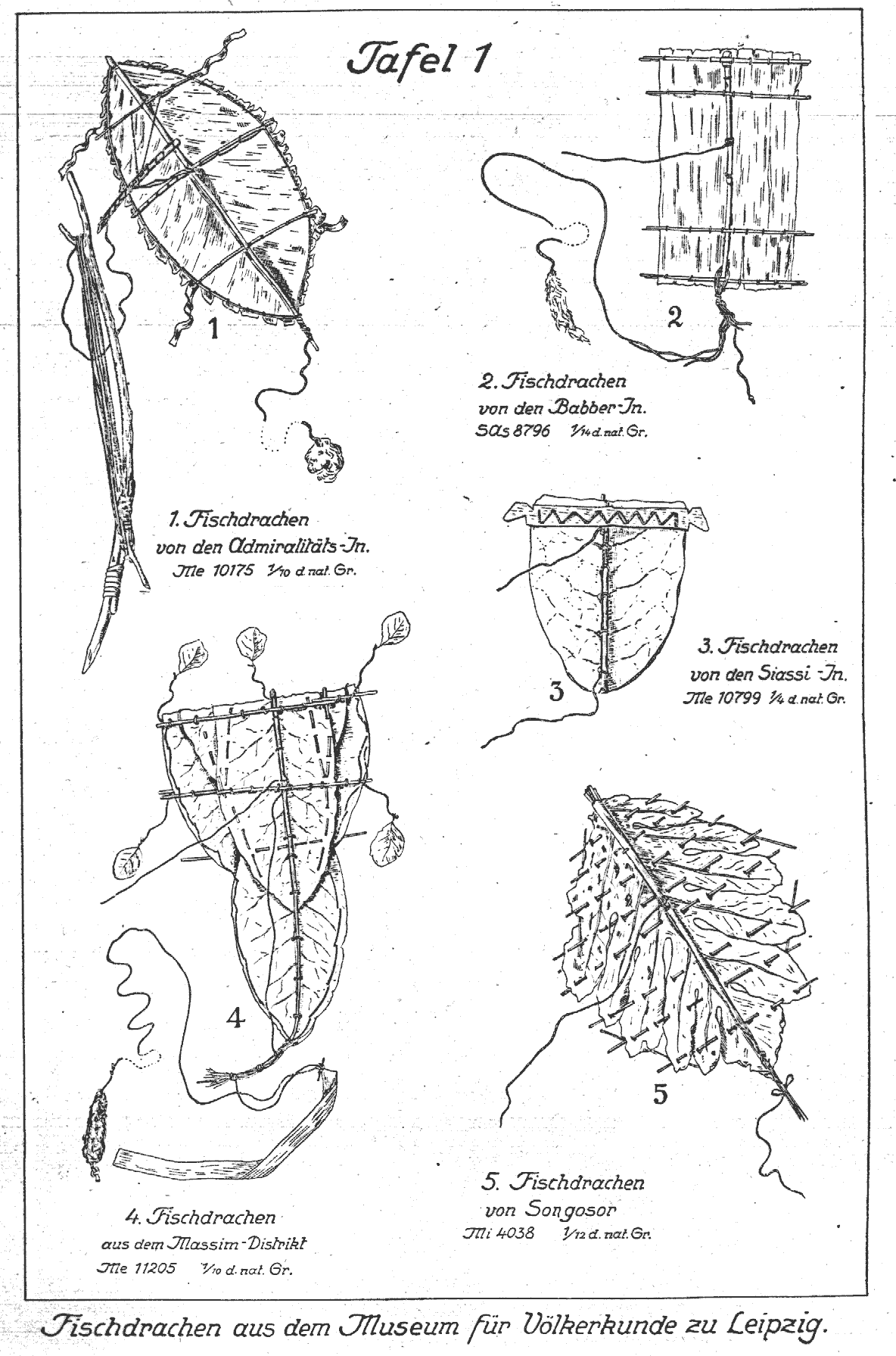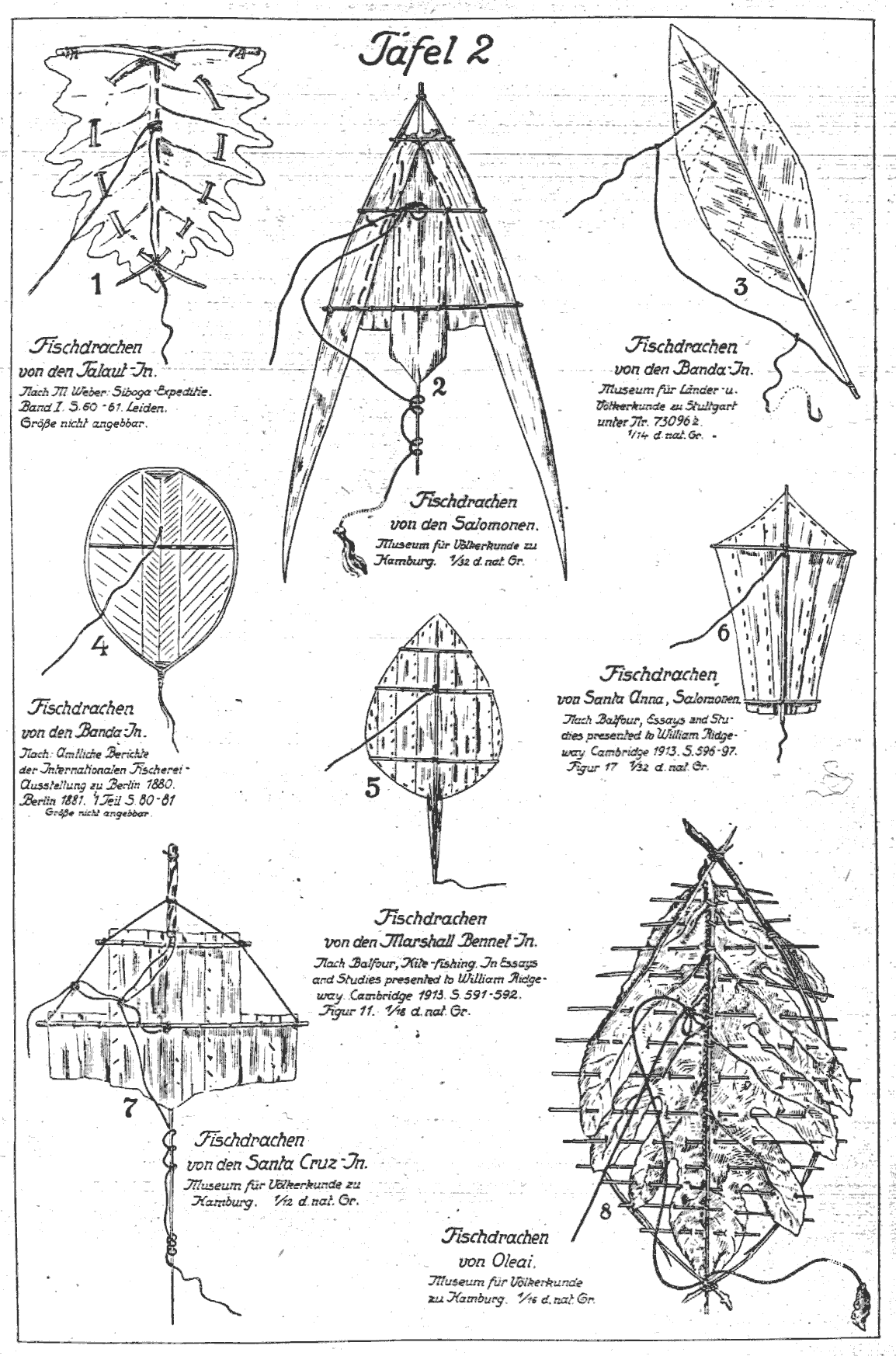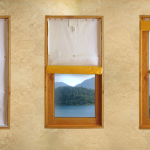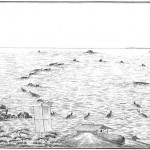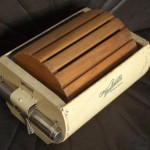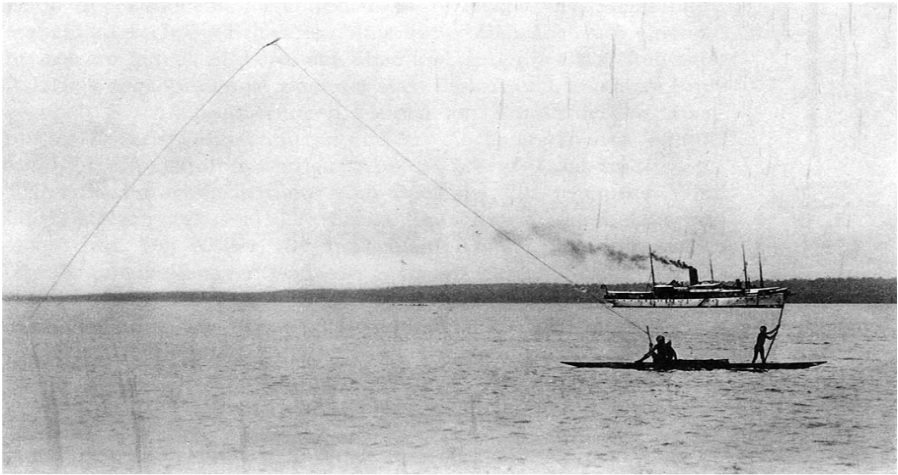
“We set out to sea but kept close to the canoe occupied by the two fishermen. Off the island the old fisherman gradually played out the kite. As it swung in the breeze we noticed that the webbing just had enough length so that it touched the surface of the sea with every soft fall of the canoe as it rose and dipped. Presently there was an agitation in the sea behind the canoe and we could see several fish coming to the surface. Apparently intrigued by the tantalizing touching of the surface by the webbing, the fish were jumping for it. Finally one caught the webbing in his mounth and with a shout, the old fisherman neatly hooked it in with a hand net.”
Picture: Kite-Fishing off Pitilu (Admiralty Islands) as photographed in 1908 by H. Vogel of the Hamburg Südsee Expedition.
The account of the first Dutch visit to the Moluccas in the summer of 1599 includes a panorama of Ternate [Illustration below]. It is quite common that such depictions of coastal towns and roadsteads show, scattered upon the waters, a number of native craft.
Among the boats is one illustrating a fishing technique which has been specific to Indonesian waters (and to the Moluccas in particular), to the Caroline Islands and parts of the Southwest Pacific, namely kite-fishing. The panorama of Ternate is the earliest record of kite-fishing in European literature. (In addition to kite-fishing the Ternate panorama also offers the earliest depiction in European sources of flying a plane kite).
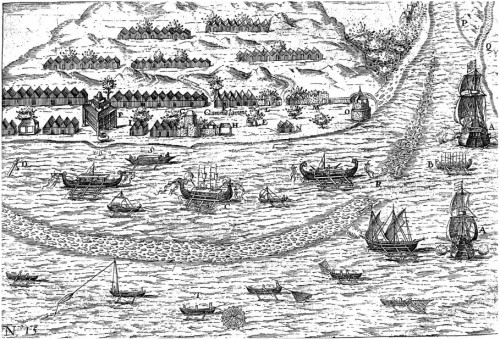
Illustration: Panorama of Ternate, published in the account of the ‘Second Voyage’ under J. van Neck and W. Warwijck 1598-1600.
Kite-fishing involves a kite and cordage, the first length of which serves as a kite-line and the second as a combined tail and fishing line. At the end of the latter is attached a lure, usually, and according to region, consisting of a baited running noose or a wad of spider-web. Fishing is carried out from the boat, involving one or two people for paddling, flying the kite and hauling in the line when a fish is caught. It is a rather specialised method targeting one particular kind of fish, i.e. certain members of the needlefish family.
In the latter part of the nineteenth century this fishing technique entered the purview of Western observers in these regions. The etnographic record is uneven and intermittent, leading to a somewhat more complete picture only by the late twentieth century. It seems all the more remarkable therefore, that in 1599 an anonymous member of a Dutch voyage should observe and describe the practice, and that it found its way into an illustration of the voyage.
Ready Grown Kite
The description neatly mentions two details typical of Indonesian waters: the single-leaf kite and the pole. In various localities (among them the Thousand Islands, Bawean and Ambon), fishing kites were directly derived from a single plant leaf, without any, or sometimes just one, further constructive element: a strengthening of the central axis.
A typical plant providing a ‘ready grown kite’ was and is the Oak Leaf Fern, and as such it was also reported relative to Ambon and Seram in the second half of the seventeenth century by Rumphius. The other detail, the use of a pole for flying the kite rather than flying it from the hand, has also been documented in recent etnographic observations. This method often accompanies the use of a single leaf kite. A minor but precise detail is the hole at the tip of the pole.
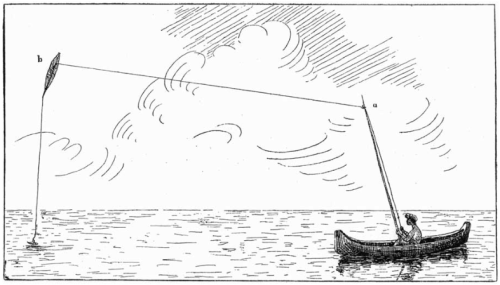
Illustration: Moluccan kite-fishing, Banda, 1899.
Some fishing kites bear all the marks of the ‘proper’ kite — a frame with a sail fixed onto it (even if the materials are simple) — which can reach considerable altitudes. The single-leaf kite, as it was observed in 1599 and in later centuries, is quite different. Its small size and its form create certain problems with lift and flight stability.
A Plaything of the Wind
It does not reach a high altitude and its flight is characterized by jerky and erratic movements, suddenly dipping and soaring again, and jumping to right and left: more a plaything of the wind than something cleverly controlled by man. In this context, the pole is important for it helps keep the leaf kite at an altitude which corresponds roughly to the length of the pole (which would be relatively long: about three to six metres). Also, the total line length is considerably shorter than for other types of kite, which allows some degree of control.
It would be mistaken to see in it a ‘proto-form’ or ‘primitive kite’, the precursor of ‘proper kites’. The jerky flight of the leaf kite is not the result of deficiencies in, or ignorance about, construction (which would later be overcome), because the jerkiness is intended. It keeps the lure in motion without the necessity for moving the pole to and fro, while the jerky movements of the lure attract the fish. In other words, in the technical process of making a device adapted to a particular target, the ‘simple’ kite is simply perfect.
In addition, in the process of fishing, the kite is exposed to wear and tear and eventually breaks (for this reason, and in certain localities, people chose to replace the leaf with plastic sheet), so it would make little sense to expose an elaborate and artistic kite to such conditions. Thus the identification of a suitable leaf (not just any will do) from a plant which grows naturally makes optimal use of environmental resources for a specific technical use.
Different kite configurations throughout the Indo-Pacific, Hans Plischke,”Der Fischdrachen“, 1922. The designs range from an astute selection of a leaf tailor-made for flying without modification to complicated kites assembled from processed leaves and sticks with enhanced flying abilities obtained from magic attachments.
Quoted from:
- “Flying a kite and catching fish in the Ternate panorama of 1600” (PDF), Stefan Dietrich, in The Journal of the Hakluyt Society, August 2012.
- “This Ingenious and Singular Apparatus: Fishing Kites of the Indo-Pacific” (Google Books), Gerry Barton and Stefan Dietrich, 2009
More low-tech fishing. More kites.
———————————————————————————————————————————————-
Update:
Mathew Lippincott sends us the following comment:
Kite fishing is one of my favorite topics. Here are my collected links and resources from over the years. The videos of SE Asian kite fishing are the most fun part. While SE Asian kite fishers go exclusively after gar, sport fishers in the Gulf of Mexico and especially New Zealand have developed divergent techniques for going after a variety of other fish. Kite fishing is a stellar example of contemporary high-strength synthetic materials combined with simple mechanical principles to create very effective low tech systems.
SE Asian kite fishing for gar:
contemporary indonesian kite fishing
http://youtu.be/apFsC4yxgNk
melanesian kite fishing with a leaf kite:
http://youtu.be/mdDFZphXAiw
contemporary/traditional kite fishing in SE Asia (spanish):
https://www.youtube.com/watch?v=KFSBnmAC4L8
Clive Hart’s “Kites: an Historical Survey” has the most extensive chapter I know of on SE Asian, Melanesian & Polynesian kites. I highly recommend it: http://drachenstore.easystorecreator.net/items/books~media/publications/kites-an-historical-survey-p025-detail.htm
(Paul Barnes is the master of this)
https://www.youtube.com/watch?v=WjDznk_CTlk
My breakdown of paul’s off-wind flying techniques:
http://publiclab.org/notes/mathew/2-1-2013/how-pauls-fishing-kites-flys-wind
Paul’s company:
http://www.fishingkites.co.nz/htmfiles/fishingkited.htm
Gulf Coast techniques:
They’ve started flying with helium balloons to help their kites lift, and also use weights to fly off-wind. Not sure where they got the square kites, but these are much closer in style to SE Asian kites.
http://youtu.be/TRomyZTkGAQ
